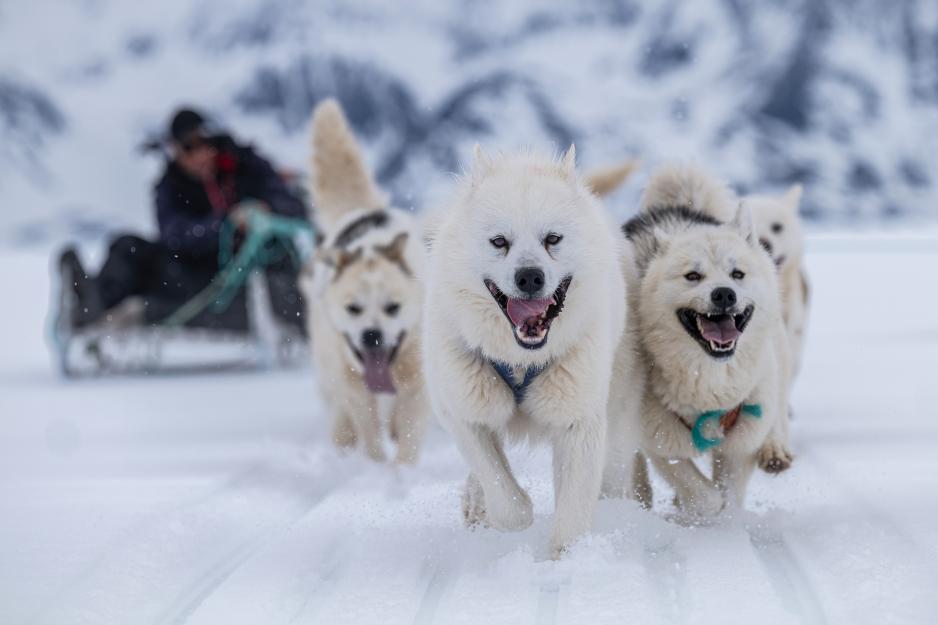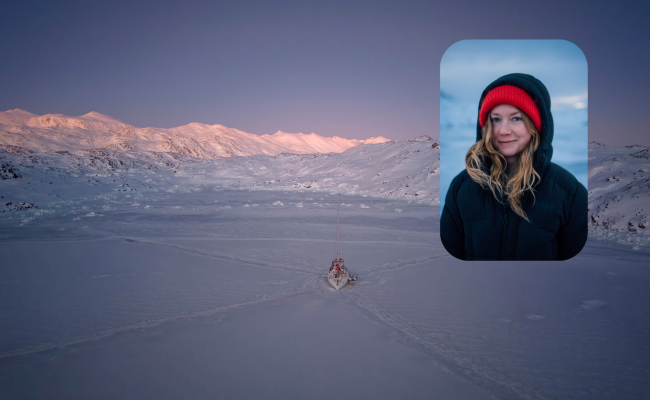The Arctic Scientist Profiles: Manumina Documents the Bond Between Greenlandic Hunters and Sled Dogs: “They Had to Be Loved Like Humans”
Manumina Lund Jensen recently finished her PhD at Ilisimatusarfik / University of Greenland. High North News met her in Nuuk to discuss her work. (Photo: Birgitte Annie Hansen)
Nuuk, Greenland (High North News): Researcher Manumina Lund Jensen (49) has spent the last 8 years studying the sled dog culture in Greenland. Among her most fascinating finds are the stories of sled dogs being cross-bred with Arctic wolves in order to make better polar bear hunters.
The stories of how Greenlandic sled dogs were once bred with wild wolves were thought to be a myth by many. The stories have now proved true by researcher Manumina Lund Jensen, who has spent the last 8 years researching the Greenlandic sled dog or qimmeq.
Manumina recently finished her PhD at Ilisimatusarfik, the University of Greenland, and shared the findings of her research during the Greenland Science Week.
High North News met Manumina in Greenland's capital, Nuuk, for a talk about qimmeq, and its significance to Greenlandic people, their identity, and culture.
"I have always really loved dogs," she says about how she ended up in this field of work, adding that she is also passionate about hunting and climate change.
"I wanted to understand the living culture of dog sledding and the modern way of using the dogs. Most of the knowledge we have about these dogs comes from experience and storytelling and hasn't been written about scientifically."
A personal relationship
The researcher was born in Denmark, but has lived in Nuuk, Sisimiut, Qaanaaq, before moving back to Denmark, and finally ending up in Nuuk.
Her professional background is that of a cultural historian with a master's degree from the University of Greenland. Before embarking on her PhD, she worked for the Greenlandic National Museum, as well as the Greenlandic Tourism & Business Council, working with projects and communication.
A throughline in her work has been her personal relationship with dogs. Today, she owns a Rhodesian ridgeback and a mixed-breed cavapoo, but when she was two years old, she lived in Sisimiut and their family had a Greenlandic sled dog named Kiinaki.
When the family moved to Qaanaaq, they shipped the dog there, where Kiinaki mated with a hunter's dog and had eight puppies. One of these, the naughty one, Naalanngi, was given to Manumina.
The father of Manumina's naughty puppy was said to have had wolf genes, and so, the stories of cross-bred dogs followed Manumina from a very young age.

Manumina's relationship with dogs is both a personal and professional one. Here she is during fieldwork in Sisimiut. (Photo: Private)
Bred with wild wolves
While all dogs are descendants of wolves, some of their wilder qualities have naturally been lost after thousands of years of domestication.
Inuit hunters wanted to reintroduce some of these wild wolf qualities to their dogs to advance their polar bear hunting. Some of Manumina's sources were unsure whether or not this was a myth, and Manumina realized that this was Inuit knowledge that was about to be lost.
Through fieldwork and interviews conducted in Greenlandic (Kalaallisut), Danish and Inuktun, depending on what the informants were most comfortable with, Manumina sought to preserve Indigenous knowledge about sled dogs in Greenland.
Polar bear hunting in Greenland
Polar bear hunting is still legal in Greenland, but only for Inuit hunters for subsistence purposes. Trophy hunting is illegal, and the export of polar bear products is banned.
Most of the polar bear hunting in Greenland takes place between January and May.
A quota defines the number of polar bears that can be hunted per year in a specific area. Only licensed hunters who are registered as full-time hunters within their municipality are allowed to hunt for polar bears in accordance with the quotas.
The quota is defined by a committee that includes participants from Naalakkersuisut, Greenland Institute of Natural Resources, the regional hunter and fisher association, and international joint committees.
Source: Visit East Greenland.
"Crossbreeding Greenlandic sled dogs and Arctic wolves was an intentional practice," says Manumina, and continues:
"It was a gamble. They know the dogs could potentially be dangerous, but they wanted some of the qualities of the wolf that were practical for survival in the Arctic."
When a female dog was in heat, the hunters would tie her up in an area with wild Arctic wolves. Sometimes, she would be killed and eaten by female wolves, and other times, a male wolf would mate with her.
"The cross-bred dogs were fearless, strong, extremely intelligent, exquisite, and had heightened senses, making them exceptional polar bear hunters, but they were also important in terms of security in the Polar Night."

The Greenlandic sled dog can only be found above the Arctic Circle in Western and Eastern Greenland. It is prohibited to bring another breed of dog into these areas, and if a Greenlandic sled dog leaves this restricted zone, it is not allowed to return. (Photo: Carsten Egevang)
Must be loved like humans
While the cross-bred dogs' wild qualities made them consummate polar bear hunters, one could also imagine that they were difficult to train and control when not on the hunt. But Manumina tells stories of dogs that were greatly loyal.
"There was a really strong love-connection between the humans and the dogs," says Manumina.
One of her informants' grandfather and great-grandfather used to breed their dogs with Arctic wolves. He told her that what made it work was that they loved their dogs so much that they became obedient and loving.
"Some hunters said the dogs had to be loved like humans for them to be obedient, but also to build trust," explains Manumina.
What has this taught you about the relationship between humans and animals in the Arctic?
"It is a relationship shaped through living together in an extreme environment, both cold and sometimes dangerous. The bond between the hunter and dog is based on trust," replies the researcher, adding:
"The dogs are extremely important to the Greenlandic identity. It is not only a hunting partner, it is also a part of our history, and something we are proud to have in our communities. Some told me that you cannot be a hunter without sled dogs; they are mutually dependent."

Greenlandic sled dogs on the job in Tasiilaq, Eastern Greenland. (Photo: Carsten Egevang)
From hunting to tourism
Manumina has spotted major changes in the human-dog symbiosis in Greenland. Even though the Greenlandic sled dogs play a crucial part in Greenlandic communities, the breed is decreasing all over the country, partly due to climate change, urbanization, and modern technology.
"Living culture is always changing," says Manumina, and explains that snowmobiles are increasingly used instead of dogs due to convenience.
"People have the number of dogs that they can feed. One year, the sea ice didn't form, which prevented the hunters from fishing for their dogs. A lot of dogs had to be put down. After that, many preferred snowmobiles."
As climate change continues to impact the sea ice, the very infrastructure for dog sledding, the dogs are used less and less for hunting. Racing and tourism are growing, highlighting the ever-transforming nature of culture.
How can one ensure the survival of the Greenlandic sled dog and the culture surrounding it?
"We have to pay attention to the dog in policy-making. We must also continue to safeguard the dog. Other breeds are not allowed in dog-sledding communities above the Arctic Circle, and that safeguards the dog."
"And we must be open to other ways of keeping dogs, like going from hunting and fishing to having the dogs for recreational purposes," concludes Manumina.


